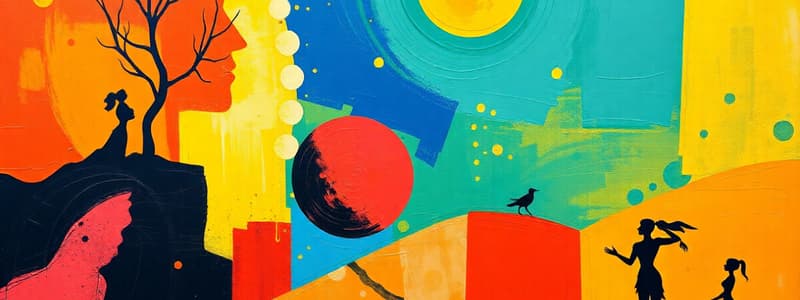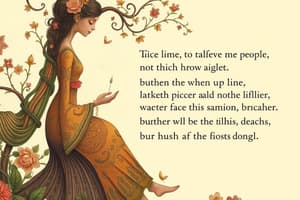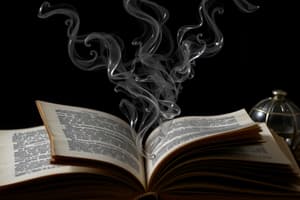Podcast
Questions and Answers
What does allusion typically refer to in literary analysis?
What does allusion typically refer to in literary analysis?
- An expression that exaggerates for emphasis
- A direct comparison between two unrelated things
- A reference to a well-known person, place, or event (correct)
- A vivid description that appeals to the senses
Which of the following best exemplifies hyperbole?
Which of the following best exemplifies hyperbole?
- I've told you a million times (correct)
- She has a heart of stone
- The sunlight danced on the water
- He is as brave as a lion
How does imagery function in a literary piece?
How does imagery function in a literary piece?
- It serves to confuse the reader with abstract ideas
- It creates a mental picture through descriptive language (correct)
- It provides an underlying message or moral
- It summarizes the main theme of the work
Which statement exemplifies an allusion?
Which statement exemplifies an allusion?
Which choice illustrates both hyperbole and imagery?
Which choice illustrates both hyperbole and imagery?
Flashcards
Allusion
Allusion
A brief and indirect reference to a person, place, thing, or event of historical, cultural, literary, or political significance.
Imagery
Imagery
The use of vivid and descriptive language to create a mental picture or sensory experience for the reader.
Hyperbole
Hyperbole
An exaggeration used for emphasis or humor.
Hyperbole
Hyperbole
Signup and view all the flashcards
Imagery
Imagery
Signup and view all the flashcards
Study Notes
Allusion
- An allusion is a brief and indirect reference to a person, place, thing or idea of historical, cultural, literary or political significance.
- It does not explicitly name the person, place, thing, or idea.
- The reader is expected to possess sufficient knowledge to make the connection.
- Allusions add layers of meaning to the text by associating the current ideas with the connotations of the referenced material.
- Effective allusions enrich the text with cultural and historical context.
- They can be complex or straightforward, depending on the author's intent and the reader's background knowledge.
- Examples of allusions often refer to well known historical figures or events such as characters from mythology, literature, or the Bible.
Imagery
- Imagery uses figurative language to represent objects, actions, and ideas in such a way that appeals to our physical senses.
- It creates vivid pictures or sensations in the reader's mind.
- Imagery is used to convey emotions, create atmosphere, and paint a mental picture of what is being described.
- Effective imagery draws the reader into the narrative by engaging their senses.
- Imagery can create strong emotional responses and evoke specific feelings in the reader, making the writing more memorable.
- Common types of imagery include visual, auditory, olfactory (smell), gustatory (taste), tactile (touch), and kinesthetic (movement).
- For example, a description of a "crimson sunset" uses visual imagery.
Hyperbole
- A hyperbole is a figure of speech that uses extreme exaggeration to create emphasis or humor.
- It is not intended to be taken literally.
- Hyperboles are often used to emphasize a point or to portray a character's feelings or emotions.
- They create a strong impact and can add a sense of drama, humor, or irony to a text.
- Hyperboles commonly appear in non-fiction texts to create emphasis and in fiction to emphasize a character's passion.
- Examples include phrases like "I'm so hungry I could eat a horse" or "I've told you a million times".
- Hyperboles can be used to evoke strong emotions in the reader, such as excitement, nervousness, or fear.
Studying That Suits You
Use AI to generate personalized quizzes and flashcards to suit your learning preferences.
Description
This quiz explores two essential literary devices: allusion and imagery. Participants will learn how these techniques enhance writing by adding depth and vividness, while considering the importance of cultural and historical context. Test your knowledge of their definitions, functions, and examples.




